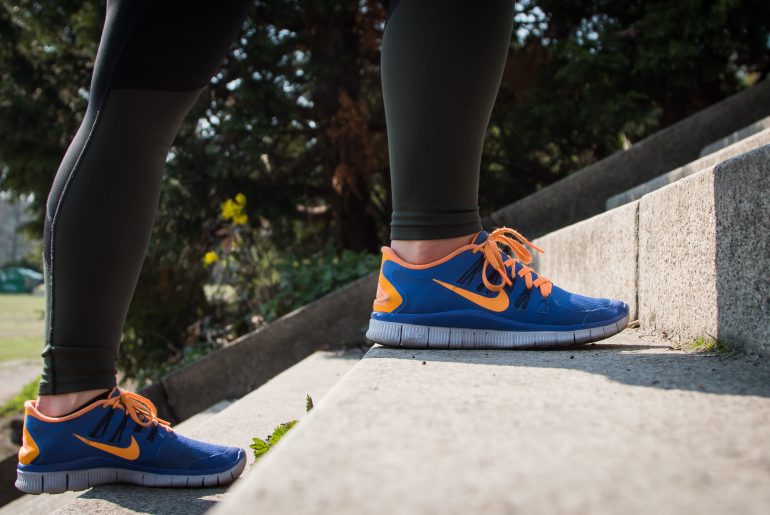One of the biggest problems from working at home can be inactivity. There’s no walking to get a cup of coffee, visiting a nearby colleague, taking the stairs to the bathroom or those incidental types of activity that come from being in a workplace with people and areas spread out. Everything is within easy reach at home. Couple that with a busy workload and this can mean sitting for as long as possible until the task is done. Suddenly hours have gone by and we’re still sitting hunched over the desk. Remaining in one posture for hours at a time can affect the muscles in your back, neck, hip flexors, hamstrings and calves. Excessive sitting can affect your metabolism, increase blood pressure, blood sugar and cholesterol – and that’s just the tip of the iceberg! Staying active when working from home may seem easy. Without the daily commute and perhaps having more flexibility in your working hours, surely being at home affords you more time to spend on exercise? Whilst this may be true in theory, we may quickly fall into routines that do not prioritise healthy activity and the boundaries between work and personal life become blurred. The best…
Suddenly Sedentary: How I Learned to Move More in Medical School
A personal story of sitting less and moving more by Connor Soles Before coming to Queensland to study in the Doctor of Medicine program I considered myself an active person. I commuted by bicycle to my then-job as a medical scribe where I followed physicians into consultations and composed hospital charts on a mobile workstation. The hustle and bustle of the Emergency Department meant that I would cherish the rare moments that I would roll to a stop near the physicians alcove, cleverly positioned adjacent to the insta-coffee machine, and slump into a swivel chair to polish my notes. I had never experienced what it was like to be chained to a workstation seated, unmoving, for long periods of time before beginning medical school, and I’d never had to learn how not to be. In my newly (half) furnished apartment (in Brisbane) I found that I could not escape our IKEA table turned desk, which was the only assembled piece of furniture aside from the couch. As a medical student studying now consumed and overwhelmed the majority of my waking hours, that and maintaining my relationship with my fiance who had accompanied me to Australia, left little time for my…
How You Can Sit Less and Move More When Working From Home
These days many workplaces have flexible working arrangements that enable staff to work from home (telecommute) one or more days a week. Telecommuting can reduce business expenses significantly and increase employee satisfaction and productivity. The advantages for staff working from home are many: You can wear comfy clothes A custom environment with as little or as much noise as you like It’s easier to make calls No office distractions Zero commuting Save money However, even when you are working from home, the majority of your time is likely to still be spent sitting at a desk or table. Our main reaction to a busy workload is to sit for as long as possible until the task is done. Before you know it, hours have gone by and you have not moved from your chair. Excessive sitting can affect your metabolism, including your blood sugars and fats, putting you at increased risk of diabetes and cardiovascular disease. Remaining in one posture for hours at a time can also affect the muscles in your back, neck, hip flexors, hamstrings and calves. Here are some tips to sitting less and moving more on your telecommuting days: Take regular breaks during your day to…
Get the Commonwealth Standing
I was perusing the British movement blog Get Britain Standing when I came across their solutions page. Get Britain Standing is a resource for employers much like Australia’s BeUpstanding, which focuses on a healthier Britain by reducing the prolonged hours of sitting that accompany many jobs. Their upcoming nationwide event On Your Feet Britain is set for April 24th 2020 with a reported ~2 million office workers participating. Get Britain Standing accounts that Briton’s working hours contribute ~70% of the daily sedentary health burden. Dr. Stuart Biddle, a professor of Active Living and Public Health is quoted on their website acknowledging the growing body of evidence that to be healthy we must move dynamically throughout the day. Which leads me to what excited me about their Solutions page: the balance board section! The benefit being, as long as you don’t fall off, strengthening your balance and your core muscles at your standing desk. They come in a variety of styles from the simple sea-saw, the log roll, and even the expert level half dome or as I like to call it the danger dome! (see image) Maybe don’t tell HR about the nickname when you bring one to the office.…
The Goldilocks Zone for Movement
It takes no large leap of the imagination to see that the human body was not shaped for a life in an office chair, car, or couch. Our ancestors were habitual movers constantly engaging in mild to moderate exercise. That is all well and good you may say, but as westerners with lives dominated by sedentary behaviour exercise must be supplemented back into our lives. A recent meta-analysis on movement lays out guidelines for a “Goldilocks” zone of exercise for maximal health benefits. This approach bestows maximal benefit with as little as 50 minutes per week (equivalent to running just 5-6 miles). The study emphasised diminishing returns from daily high aerobic exercise in favour of more frequent low to moderate exercise such as walking or yoga. The study references of cohort of daily endurance athletes over the age of 45 who were measured to have an increased risk for cardiovascular events as compared to those with a more moderate activity profile. Key Take Aways: Sitting should be limited to 30 minutes at a time punctuated by a “brisk” 5 minute walk Use a sit-standing desk when possible to alternate postures regularly There is no upper limit for mild to moderate…
Sitting can slow your stomach – Part 1
Have you ever experienced stomach pains, discomfort, or indigestion after sitting too long at your desk? While exercise has long been anecdotally thought to influence digestion, more recent research has been exploring the impact of physical inactivity on digestion. This post will explore some ways exercise and inactivity influences your gut, as well as the implications for your health. But first, what does it mean to say that sitting “slows your stomach?” One way to consider it would be gastric emptying, or the movement of stomach contents into the small intestine (how quickly food leaves the stomach). Another possibility is gastrointestinal transit time, which is the time it takes something you eat to move from your mouth through your entire gastrointestinal tract. Both these definitions have been linked to physical activity and inactivity, as have health outcomes such as constipation and colorectal cancer. How physical inactivity slows your stomach: When you aren’t moving, your gut isn’t moving much either. An extreme example can be seen in people who are confined to bed or held immobile. Hospital inpatients are another population at risk of prolonged physical inactivity, and increased rates of constipation are seen in this population. However it can be…
“Sit less—move more and more often”: all physical activity is beneficial for longevity
This article was originally published in the BMJ Opinion on 21st August 2019. New research shows that any level of movement decreases risk of premature death, so get moving say Ulf Ekelund and Thomas Yates It is well established that physical activity of a moderate or vigorous intensity (such as brisk walking) is good for your health. More recently, it has also been shown that people in contemporary societies are spending the majority of their day sitting, and that this prolonged sitting is also linked to an increased risk for many chronic diseases and premature death. Current physical activity recommendations, including those recently updated for the US, suggest that at least 150 minutes per week of moderate intensity physical activity is needed to keep healthy and that prolonged sitting should be avoided. However, how much sitting is too much? This is not specified and is widely debated. In addition, are levels of physical activity below those recommended still beneficial for health and does light intensity physical activity still count? Answering these questions have huge relevance for health promotion. We performed a study to address these questions. Our results suggest strong associations between total physical activity and the risk of dying.…
An Exercise Regimen Everyone Can Squeeze In
The following article was written by Emmanuel Stamatakis and published in The Conversation on the 21st February 2019. Have you recently carried heavy shopping bags up a few flights of stairs? Or run the last 100 metres to the station to catch your train? If you have, you may have unknowingly been doing a style of exercise called high-intensity incidental physical activity. Our paper, published today in the British Journal of Sports Medicine, shows this type of regular, incidental activity that gets you huffing and puffing is likely to produce health benefits, even if you do it in 30-second bursts, spread over the day. In fact, incorporating more high intensity activity into our daily routines – whether that’s by vacuuming the carpet with vigour or walking uphill to buy your lunch – could be the key to helping all of us get some high quality exercise each day. And that includes people who are overweight and unfit. What is high intensity exercise? Until recently, most health authorities prescribed activity lasting for at least ten continuous minutes, although there was no credible scientific evidence behind this. This recommendation was recently refuted by the 2018 US Physical Activity Guidelines Advisory Report. The new…
Moving More During Your Commute
With BeUpstanding™, we’re always trying to incorporate ways to stand up, sit less, and move more throughout the day. While we often think about sitting less in the workplace, another time to reduce sitting is on the way to the workplace. Around 78% of Australians commute by car. Sitting in the car can lead to negative health outcomes especially with longer commutes. Commuting distance is associated with increased body fat and decreased fitness level. Active commuting (walking or cycling) on the other hand, is associated with a greater fitness level, healthier body weight, and a decreased risk for heart disease. We can all think of some barriers to active commuting. However, there are easy steps to overcome these barriers. For example, you don’t have to walk to work all the way from home. Instead, get off the bus a stop or two early and walk the rest of the way. You can also try parking further from the office to increase your step count. Cycling can seem intimidating thanks to hills along your commute route. Electric assist e-bikes can help. These bikes provide motor assistance when you pedal so that it feels like you’re always riding with the wind at…
Quick Tip – Water Bottle Replacement
Are you looking for ways to move more at work? Here’s one of our favourite tips to get you out of your seat and onto your feet. Replace your water bottle with a glass! This simple strategy forces you to stand up and walk to fill your glass every time it is empty. In addition, this is helpful because it helps remind you to drink enough water which is also important for your health. The most sustainable strategies are sometimes ones that will easily become part of your daily routine. An empty glass on your desk is a subtle reminder to stand up often. We hope this simple tip will have you up and moving about without even thinking about it. Happy moving!










